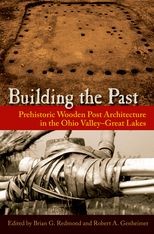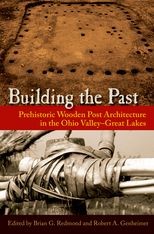Building the Past: Prehistoric Wooden Post Architecture in the Ohio Valley-Great Lakes
Building the Past: Prehistoric Wooden Post Architecture in the Ohio Valley-Great Lakes
Cite
Abstract
The study of ancient architecture and the built environment has much to tell us about the social makeup and culture of the designers, builders, and users of these constructions. This volume presents the most current research on domestic, public, and ritual architecture created over four millennia along the Ohio River, its tributaries, and in the lower Great Lakes. Most of these chapters describe new discoveries and previously unpublished data. This compilation begins with the latest information on some of the most ancient (Late Archaic) dwellings in the region which demonstrate that early cultures built sophisticated dwellings and were much more settled than previously thought. Of particular note are the chapters which provide the first published descriptions of newly discovered Hopewell domestic and ritual constructions in the central Ohio River Valley, such as the Moorehead Circle and the Brown’s Bottom domestic hamlet. Rare evidence of post-Hopewell architecture in Ohio is derived from the recent discovery of a complete early Late Woodland domestic structure at the Heckelman site in northern Ohio. The climax of domestic architecture in the region is thoroughly investigated by three analyses of Late Prehistoric period house constructions and public architecture in the central Ohio Valley and central Indiana. The volume concludes with a discussion of how archaeologists working in the region can improve our understanding of prehistoric constructions through the development of a new interpretive framework based on basic architectural principals and nomenclature.
-
Front Matter
-
1
Building the Past, an Introduction
Brian G. Redmond
-
2
Dwelling on the Past: Late Archaic Structures of the Ohio Region
Matthew P. Purtill
-
3
For Immediate Occupancy: Cozy Three-Thousand-Year-Old Heritage Winter House with River View near Lake Huron—Apply to Terminal Archaic Realty
Christopher J. Ellis and others
-
4
The Ecology of Indigenous Domestic Architecture in the Hocking River Valley, Ohio
Elliot M. Abrams andPaul E. Patton
-
5
Wooden Structures and Cultural Symbolism in Ohio Hopewell
N’omi B. Greber
-
6
The End
Robert V. Riordan
-
7
Living Large on the Bottom: A Structural Engineering Analysis of Three Ohio Hopewell Structures from Brown’s Bottom, Ross County, Ohio
Noah Kanter and others
-
8
Changes in Precontact Domestic Architecture at the Heckelman Site in Northern Ohio
Brian G. Redmond andBrian L. Scanlan
-
9
Wall Trench Structures in Fort Ancient Villages of Southwestern Ohio and Southeastern Indiana: Temporal and Formal Considerations
Robert A. Cook andRobert A. Genheimer
-
10
Building Community on the White River in Central Indiana: Structures as Reflective of Societal Change at the Late Prehistoric Castor Farm Site
Robert G. McCullough
-
11
Fort Ancient Public Structures
David Pollack andA. Gwynn Henderson
-
12
A Framework for Interpreting Structures
William Kennedy andGeoff Carter
-
End Matter
Sign in
Personal account
- Sign in with email/username & password
- Get email alerts
- Save searches
- Purchase content
- Activate your purchase/trial code
Institutional access
-
Sign in through your institution
- Sign in with a library card Sign in with username/password Recommend to your librarian
Institutional account management
Sign in as administratorPurchase
Our books are available by subscription or purchase to libraries and institutions.
Purchasing information| Month: | Total Views: |
|---|---|
| February 2023 | 1 |
| February 2023 | 1 |
| February 2023 | 1 |
| February 2023 | 2 |
| November 2023 | 2 |
| December 2023 | 3 |




Get help with access
Institutional access
Access to content on Oxford Academic is often provided through institutional subscriptions and purchases. If you are a member of an institution with an active account, you may be able to access content in one of the following ways:
IP based access
Typically, access is provided across an institutional network to a range of IP addresses. This authentication occurs automatically, and it is not possible to sign out of an IP authenticated account.
Sign in through your institution
Choose this option to get remote access when outside your institution. Shibboleth/Open Athens technology is used to provide single sign-on between your institution’s website and Oxford Academic.
If your institution is not listed or you cannot sign in to your institution’s website, please contact your librarian or administrator.
Sign in with a library card
Enter your library card number to sign in. If you cannot sign in, please contact your librarian.
Society Members
Society member access to a journal is achieved in one of the following ways:
Sign in through society site
Many societies offer single sign-on between the society website and Oxford Academic. If you see ‘Sign in through society site’ in the sign in pane within a journal:
If you do not have a society account or have forgotten your username or password, please contact your society.
Sign in using a personal account
Some societies use Oxford Academic personal accounts to provide access to their members. See below.
Personal account
A personal account can be used to get email alerts, save searches, purchase content, and activate subscriptions.
Some societies use Oxford Academic personal accounts to provide access to their members.
Viewing your signed in accounts
Click the account icon in the top right to:
Signed in but can't access content
Oxford Academic is home to a wide variety of products. The institutional subscription may not cover the content that you are trying to access. If you believe you should have access to that content, please contact your librarian.
Institutional account management
For librarians and administrators, your personal account also provides access to institutional account management. Here you will find options to view and activate subscriptions, manage institutional settings and access options, access usage statistics, and more.